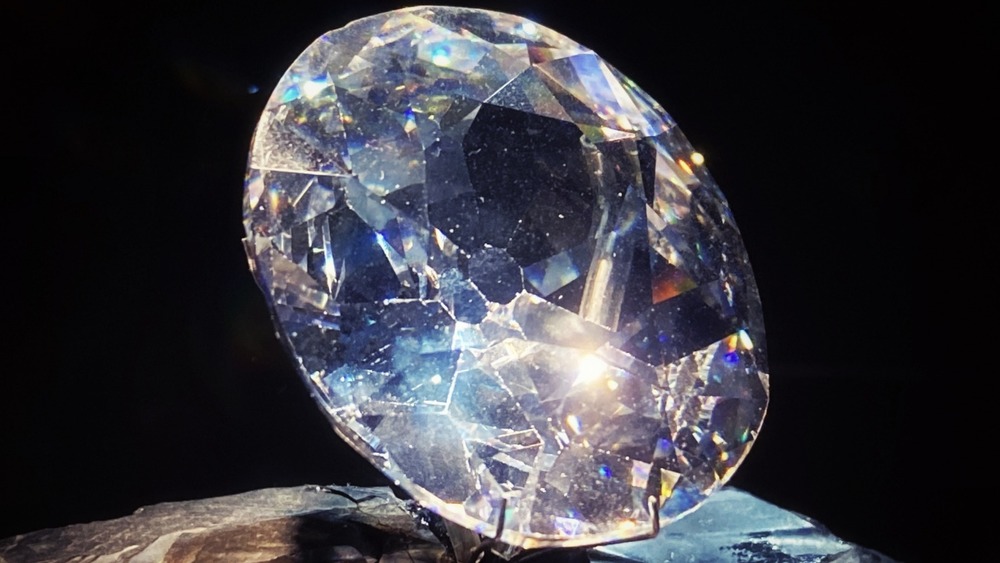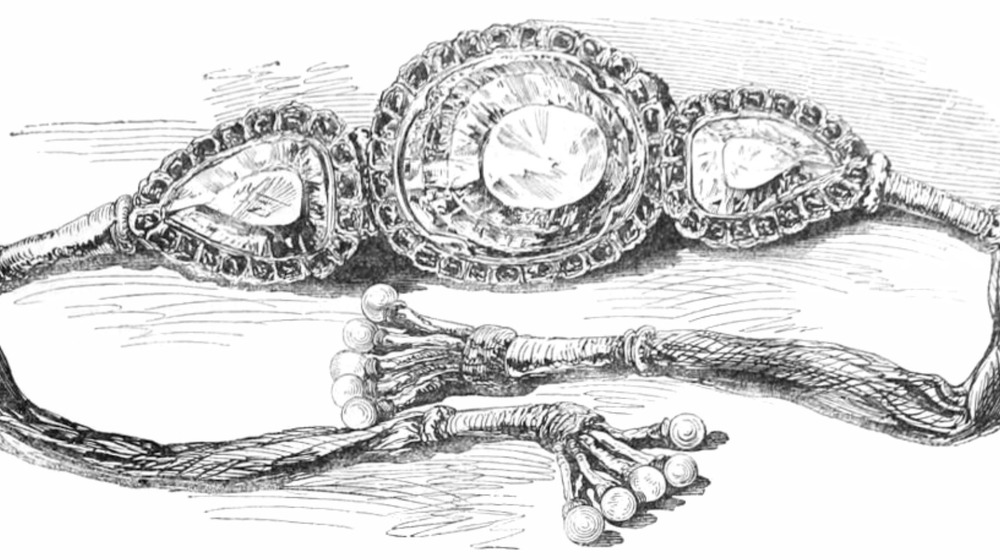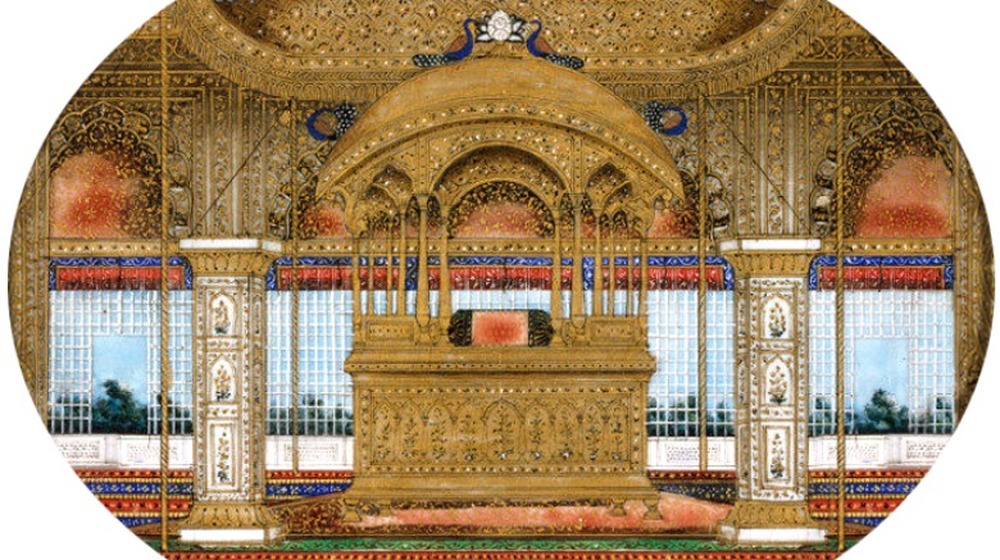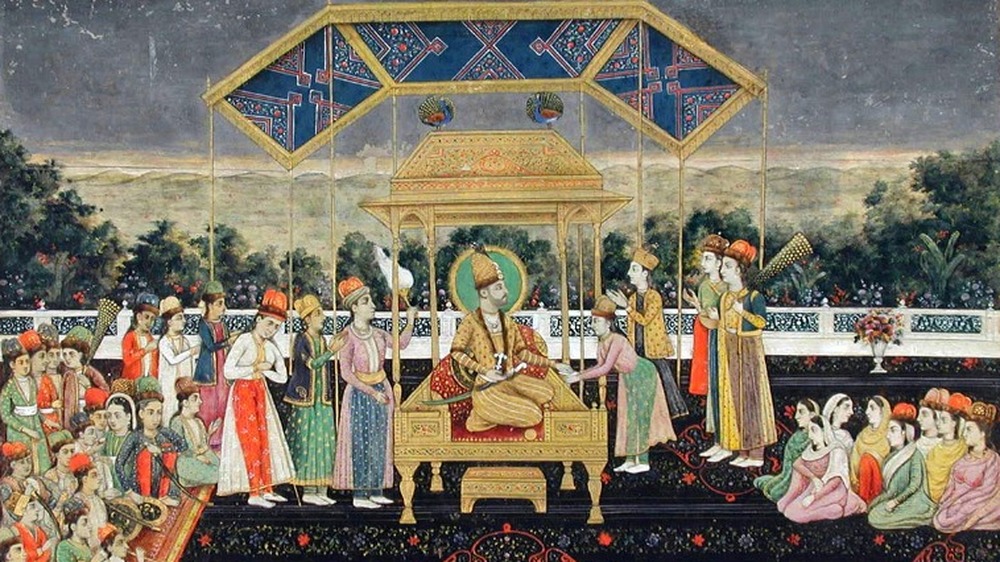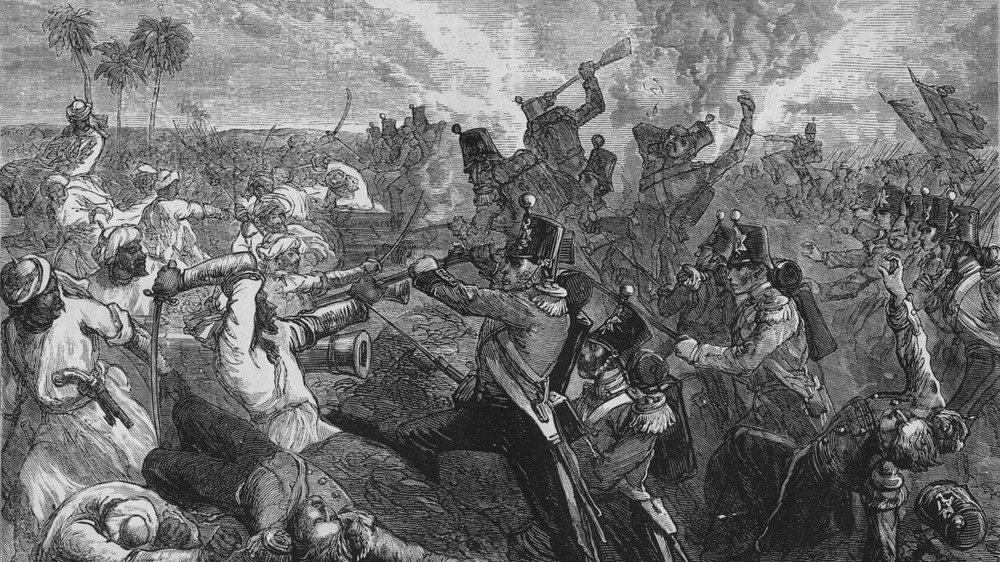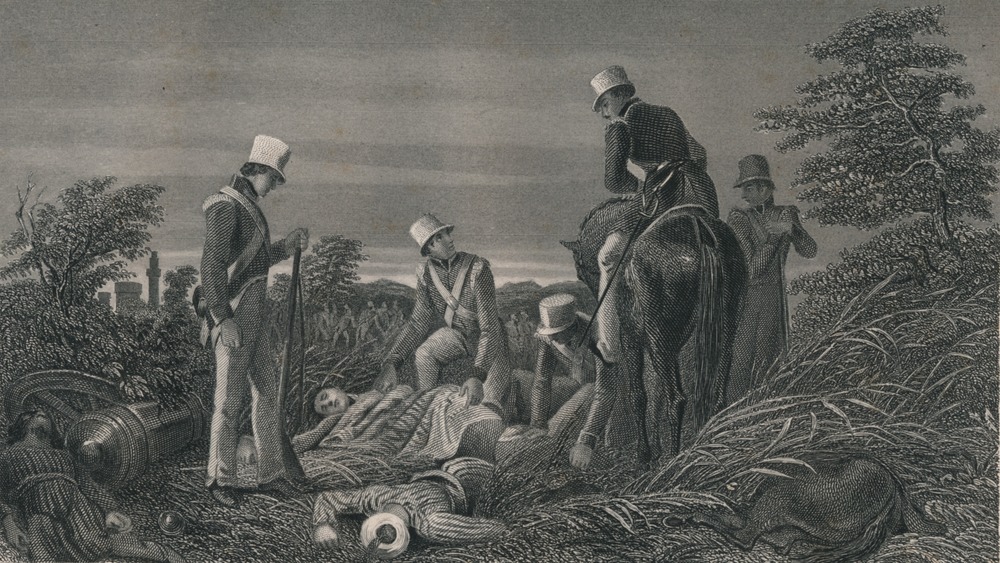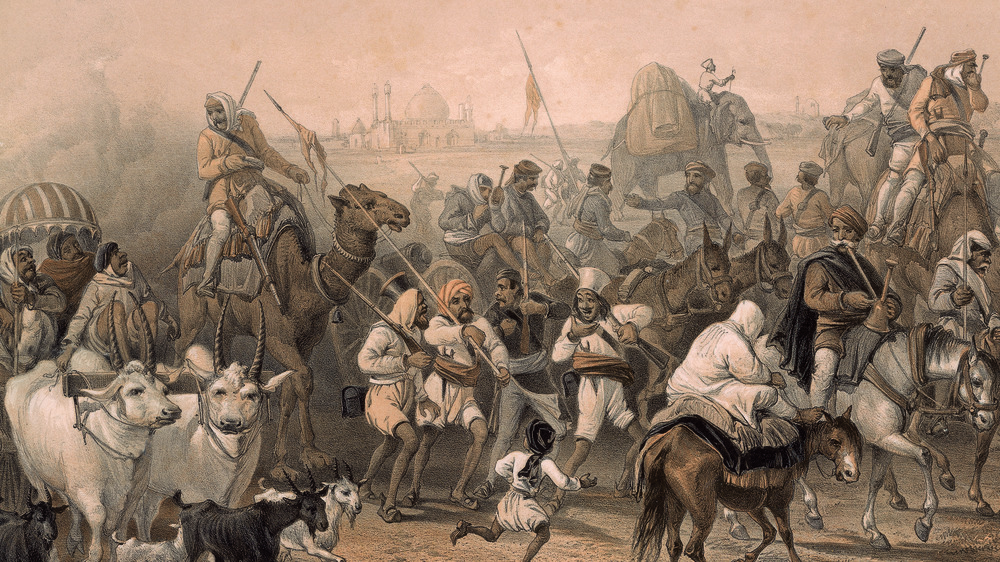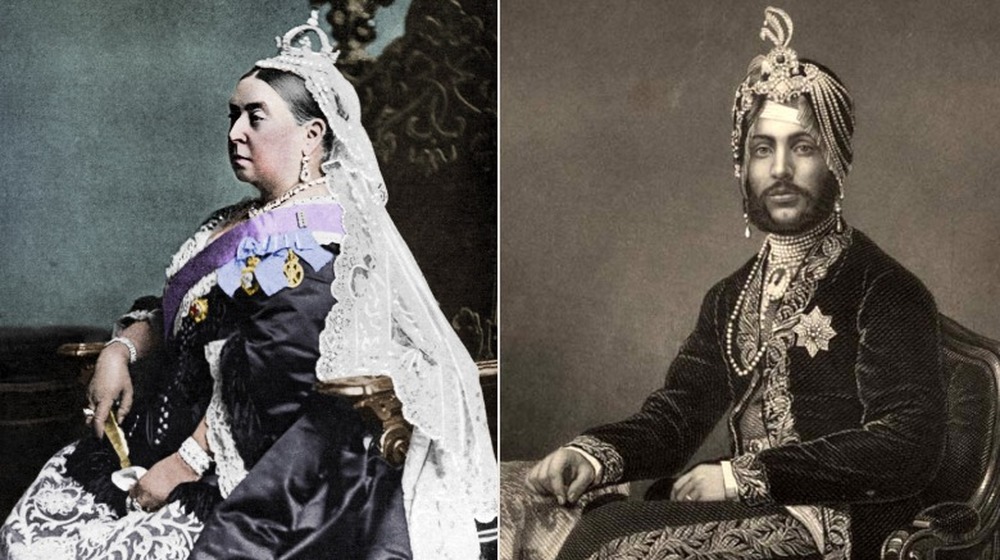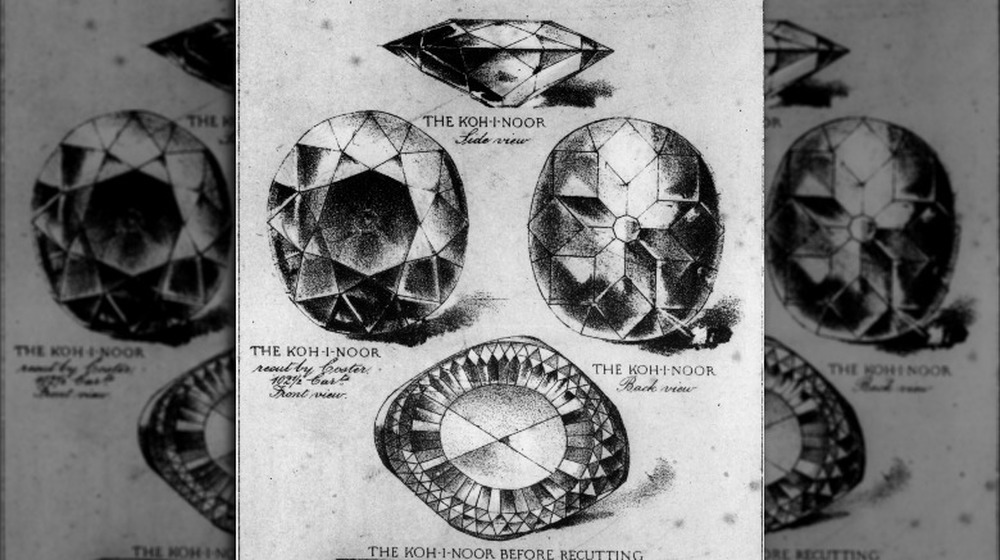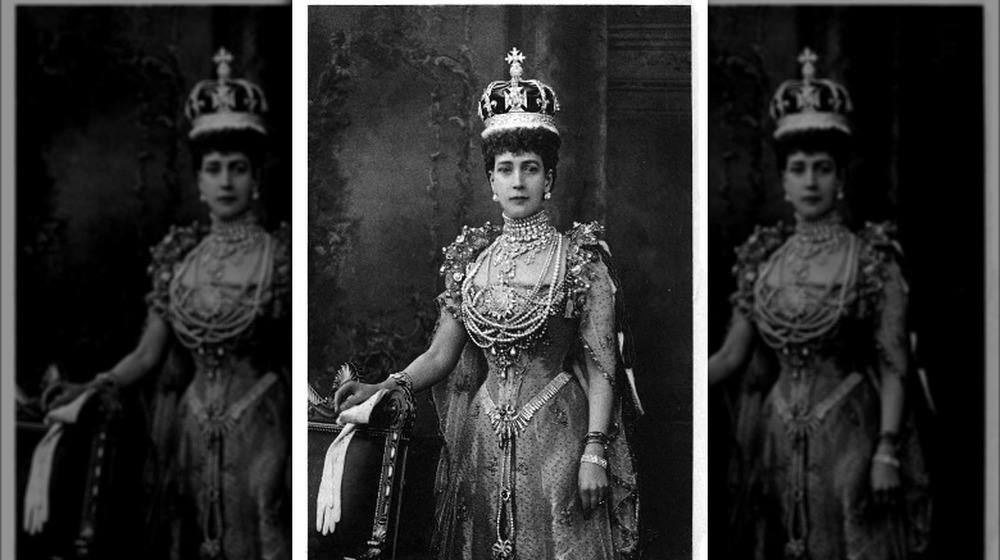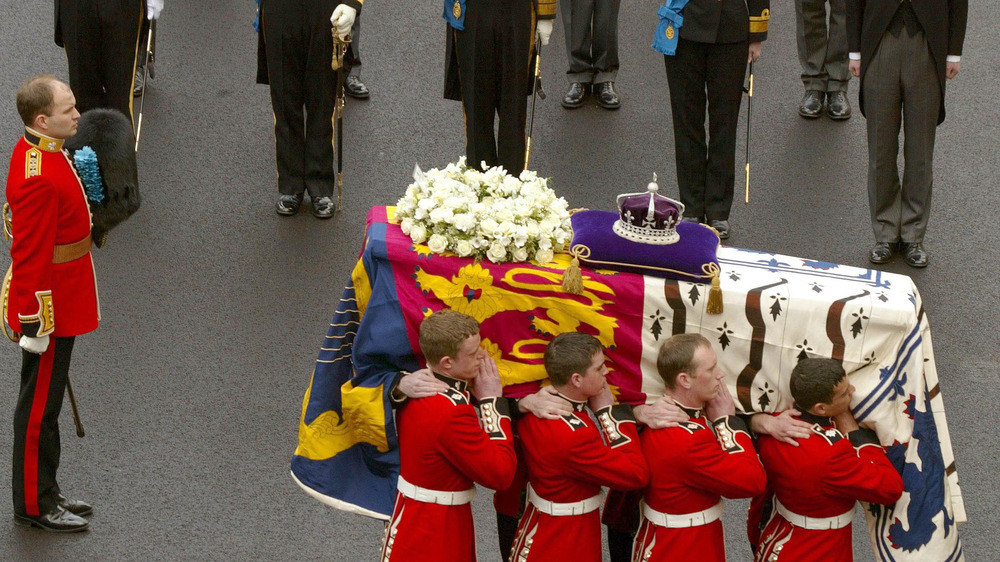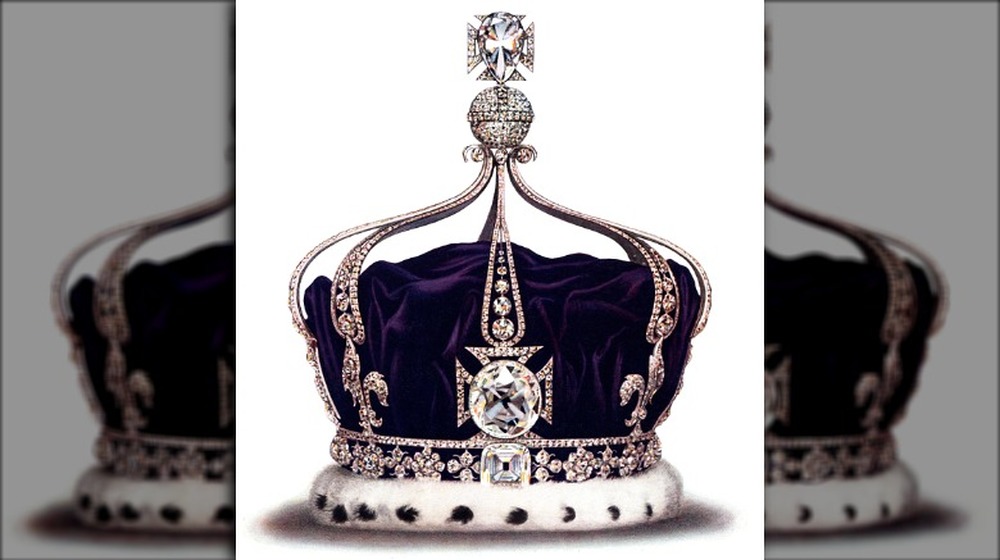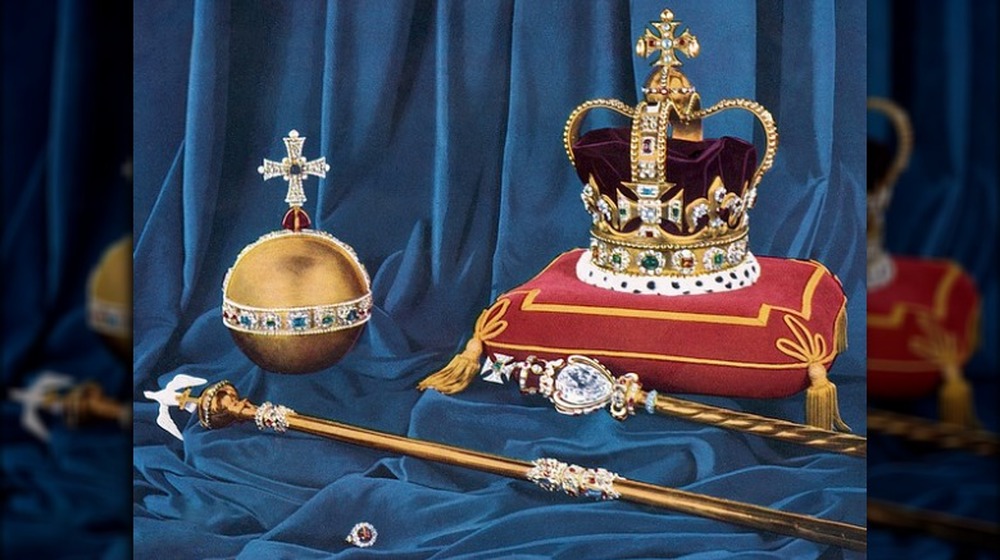The Truth About The Diamond The British Won't Give Up
Among the British Crown Jewels, there lies a well-known Indian diamond. Weighing in at 105 carats, the Koh-i-Noor (or "Mountain of Light") is an incredibly valuable gem in a collection that's already worth billions of dollars. It shines and sparkles, proving its place among many other beautiful gemstones.
But, maybe, the Koh-i-Noor doesn't belong with the Crown Jewels. Maybe it doesn't even belong in the United Kingdom at all. Maybe it belongs a whole continent away, despite the British government holding onto it.
The Koh-i-Noor has a long history that no one knows exactly, at least beyond story and myth, and its more recent history is marked with envy, bloodshed, treachery, and conquest. Oh, and it might have just a touch of dark magic, too. Really, this one shiny rock has a pretty wild tale to tell, and it's one that still has consequences even well into the 21st century.
There are a lot of myths surrounding the Koh-i-Noor
In general, there's a lot about the Koh-i-Noor that isn't entirely known, and the gem is shrouded in mystery and legend. Traditionally, it's been thought that the gem's first mention was actually in a 5,000-year-old Hindu text — the Bhagavad Purana tales (via Koh-i-Noor Diamond and the BBC). In those stories, there's a diamond called the Syamantaka, which could have been the Koh-i-Noor. Of course, that's just speculative, but were it to be true, then, per the tales, it would've been around since the time of Krishna and the rest of the Hindu pantheon of gods. Truly, it would be legendary, in that case.
So, then, how did it get its current name? A different story likes to say that a Persian conqueror — Nader Shah — sacked Delhi in the 18th century, only to realize that the prized diamond wasn't anywhere to be found (via the Independent). As it turned out, the diamond was being hidden in the turban of a member of the Mughal emperor's harem, so Shah chose to solve the problem by proposing a customary exchange of turbans. The diamond came tumbling out, and he exclaimed "koh i noor" upon seeing it, hence the name.
The thing is, that's probably not true. The location of the Koh-i-Noor at the time was actually known, and that story is one of a few so-called "facts" that have been spread, working to further the legend of the Koh-i-Noor.
The Koh-i-Noor was originally part of a throne
Even though it's not entirely known where exactly the diamond came from, there is a pretty definite first appearance of it in the written record. According to Smithsonian Magazine, the first definitive mention of the Koh-i-Noor came in 1628, specifically as a piece of a throne.
At the time, the Mughals were in charge, ruling in the northern part of India, and they had a particular fascination with gemstones (though it's sort of hard to blame them for that). On top of that, gems were used as a way to signify status and wealth, usually adorning people's bodies to really show off their power. So it followed that the Mughal ruler Shah Jahan wanted a throne for himself — one entirely encrusted in gemstones and known as the Peacock Throne.
The actual description of the throne Shah Jahan commissioned is pretty ostentatious. The entire thing was to be covered by all sorts of gems, with rubies and garnets all along the inside, while being supported by columns of emerald. The throne would also feature gem-covered peacocks. Included were particularly large gems — the Timur Ruby and the Koh-i-Noor, the latter placed in a peacock's head. (Strangely enough, despite the later fame of the Koh-i-Noor, the Mughals considered it to be the less valuable of the two. They just liked colored gems more.)
The leadership of India changed quite a bit
To really get into the history of the Koh-i-Noor, it helps a lot to know about the history of India as a whole. After all, the wealth of Indian gems (the Koh-i-Noor included) was basically a beacon to surrounding powers, calling them to try and take that wealth for themselves, usually by bloody means.
At the time of the Koh-i-Noor's first confirmed appearance, the Mughals were in charge, though the passing of power was occasionally far from peaceful (via the Independent). Eventually, the Persians began to turn their eyes toward Delhi, and Nader Shah arrived in 1739 to take what he pleased (via Smithsonian Magazine). His invasion force rampaged through the city, leaving thousands of bodies in its wake so that he could loot the overflowing treasury. Among his prizes was the Peacock Throne, though the two famous gems — the Timur Ruby and the Koh-i-Noor — were removed and set in an armband instead.
For the next several decades, the Koh-i-Noor ended up in present-day Afghanistan, surrounded by infighting by the royals. It came back to India in 1813, into the possession of Sikh ruler Ranjit Singh, who saw iit as a symbol of his power.
The Anglo-Sikh Wars
There was quite a bit of power-grabbing within India, but there were also other parties interested in the area, namely Great Britain. Throughout the early part of the 19th century, the British East India Company was expanding its reach into the Indian subcontinent, making alliances with local princes to extend their influence. Getting the Koh-i-Noor would just be the cherry on top of their conquest (via Smithsonian Magazine).
So when Ranjit Singh died in 1839, an opportunity appeared. Singh had built the Sikh state up, but over the next few years, the government was a mess, marked with turbulence (via Britannica). By the end of it, Singh's youngest son Duleep Singh, only a boy, was in charge, with his mother Jind Kaur as queen regent. In reality, though, the military had the power, and they weren't happy with the British. So they invaded the British-controlled area of India, starting the First Anglo-Sikh War in 1845, only to lose by the next year due to poor organization and a lack of unity across India as a whole (via HistoryNet).
A few years later, a couple of British officers were killed shortly after they'd arrived to govern Multan, the first step in another rebellion. Jind Kaur was implicated in the rebellion and arrested, turning more Sikhs against the British and sparking the Second Anglo-Sikh War. But the second war went much like the first (albeit with even more violent atrocities). The Sikhs surrendered, and Britain was able to fully conquer India.
Treaties between India and Britain
In the wake of the Anglo-Sikh Wars, there was definitely a need for peace, so the late 1840s included the signing of a number of different treaties — such as the Treaty of Lahore and Treaty of Bhyroval — which the British wrote heavily in their favor (via the Sikh Museum Initiative).
Duleep Singh became a ward of the British Crown and was given an annual pension, but he and his people had to give up a lot more (via the Independent). The treaties pretty much gave up all sovereignty and right for Singh or his descendants to rule over the entirety of India, surrendering that power to the British. There were even multiple sections of these treaties that specified exactly where the British government could rule, though they could pass through any part of India whenever they pleased. Besides that, the Sikh army had to shrink, losing their weapons and reorganizing in a way that was more favorable to the British. Really, the British made it so that they were the only ones with power over the treaty. Any changes needed to have their agreement, but the same isn't written in that clause for Singh.
And, of course, there was the Koh-i-Noor. A whole article within the 1849 peace treaty is dedicated just to the gem and its surrender by Singh to the queen of England. Apparently, the British had to make sure they got their sparkly prize.
British colonization wasn't taken too well
British influence had always been insidious, seeping into Indian society. It started with alliances with Indian princes but eventually escalated to the replacement of the Indian upper class with a British one (via Britannica). From there, they could do such things as pass a doctrine that prohibited Hindu rulers with no natural descendants from adopting an heir, allowing the British government to annex their lands after they died. The British wanted to project an image of being in control.
Plus, there was the creeping Westernization that the British encouraged: the destruction of the caste system, the influx of Christianity, and the changing status of women, among other things. It was uncomfortable for Indians to see their society slowly ripped apart — enough so that another rebellion, called the Sepoy Mutiny, broke out in 1857.
The rebellion lasted two years and did bring about changes, like Indian representation in the legislature, but it marked a win for Westernization and British rule. And that's spawned debates in the decades since. Was British colonialism helpful? Was the economic development as helpful as some claim or was it actually detrimental? Or was it only helpful to the British upper class?
Presenting the Koh-i-Noor to the Queen was a spectacle
The end of the Anglo-Sikh Wars ended up meaning the end of Indian sovereignty as well as the loss of the Koh-i-Noor to British hands, but, apparently, getting the diamond through a treaty wasn't quite enough. After all, where's the show in that?
Lord Dalhousie, the governor general of India, had the perfect solution, and he essentially organized a publicity stunt to really show the might of British imperialism (via the Independent). The nine-year-old Duleep Singh was taken to England, just to walk up to Queen Victoria, carrying the Koh-i-Noor on a silk cushion, and then surrender this prize — as well as the entirety of India and its wealth — to her.
The entire event was merely a symbolic spectacle. By having Singh surrender the Koh-i-Noor in such a way, it established the queen (and, by extension, Britain) as the victorious conqueror, while Singh and India had been conquered, bowing down to their British masters. It established a definite difference in power: Singh was far from an equal. He ended up becoming a ward of the British Crown, only to ultimately die poor in Paris in 1893. It's not an especially happy story.
The Koh-i-Noor was something of a symbol for the royal family
Once the Koh-i-Noor was squarely in British possession, there was no hesitation to put it on display, and in 1851, it was featured as part of the Great Exhibition (also called the Great Exposition) (via Smithsonian Magazine). Weirdly enough, the public was severely disappointed by its "simple" appearance, and Prince Albert (Queen Victoria's husband) looked to correct that, getting it cut down to 105 carats (via the Independent) and giving it a new polish. The diamond lost around half its size in the process, but at least it was sufficiently shiny.
With the Koh-i-Noor looking more beautiful, it ended up coming to adorn the jewelry of the royal family. Queen Victoria herself tended to wear the diamond as a brooch, but eventually, it ended up joining the Crown Jewels (where it's been in the years since). First, it sat in the crown of Queen Alexandra and then that of Queen Mary. After that, it came into the hands of the Queen Mother (the mother of Elizabeth II) in 1937. It had a place in her crown for a long time: The Koh-i-Noor was last seen publicly in that crown in 2002 for her funeral, as it was carried atop her coffin.
The Koh-i-Noor is thought to be cursed
After arriving in the hands of the British, the Koh-i-Noor became part of the Crown Jewels, but there's a strange pattern in the people who have actually worn this diamond. All of them have been queens, not kings, as Queen Victoria specified in her will that the Koh-i-Noor should only be worn by a queen (via Koh-i-Noor Diamond). It seems like a weirdly specific thing to insist on, but then it all makes a bit more sense knowing that the diamond is believed to carry a curse.
A Hindu text from the early 14th century reportedly says that this curse will kill any man who tries to own the Koh-i-Noor: Only God or women can safely wear it (via the Independent). It sounds like some random superstition, but the evidence almost seems to back it up.
Shah Jahan — the Mughal emperor who created the Peacock Throne in which the Koh-i-Noor was set — was imprisoned by his son and died. The Persian Nader Shah took the Koh-i-Noor from the treasury in Delhi and was later assassinated. The fate of his descendants was hardly any better, with many of them dethroned, blinded, or coronated with molten gold to the scalp. Even after it returned to India, bloody and violent wars followed.
Sure, it's hard to say if the curse is real, but the death and bloodshed that has followed the Koh-i-Noor can't be denied.
There have been requests to have the Koh-i-Noor returned
Given the way that the Koh-i-Noor was obtained (essentially as a prize of British imperialism), it's no surprise that there are people who want to see it returned to its rightful owners, and there have been a number of attempts to do so.
In August 1976, the prime minister of Pakistan, Zulfikar Ali Bhutto, wrote to British prime minister James Callaghan on the topic of the diamond (via the Independent). In that letter, written around the time of Pakistan's independence day, he talked about historical issues surrounding their subjugation and freedom from British rule, mentioning that the Koh-i-Noor had sentimental value to the people of Pakistan. On top of that, he mentioned that returning the Koh-i-Noor would have enormous symbolic value: It would show that Britain was genuine about moving past its imperial tendencies.
Similar requests have also come from India. Seeing the Koh-i-Noor set in the crown on the top of the Queen Mother's coffin in 2002 ruffled some feathers, and speculation that the same crown might potentially pass to Camilla (wife of Prince Charles) led to New Delhi requesting its return in 2005. Other petitions have been made as well (via the BBC). But despite all of that, the Koh-i-Noor is still in England. Prime minister after prime minister has refused to give it up.
The British Government has reasons not to return the Koh-i-Noor
British prime ministers over the decades have all chosen not to give up the Koh-i-Noor, though they do try to justify their ownership. On one hand, there's the simple fact that, regardless of anything else, the British have the Koh-i-Noor (via the Independent). "Possession is nine-tenths of the law" and all that. Then, there's David Cameron's statement that, should they give back the Koh-i-Noor, it would set a precedent that would lead to the complete emptying of the British Museum (via the BBC).
Plus, there's the historical path of the diamond and the way the British got their hands on it in the first place. Even Indian solicitor-general Ranjit Kumar said in 2016 that the gem was technically given to the British Empire. Of course, the circumstances can be called into question rather easily — Duleep Singh was a literal child when he had to give up the Koh-i-Noor to stop a bloody war — but the fact remains that it was included as part of a peace treaty.
The most complicated factor, though, can be summed up with one question: Who should the Koh-i-Noor be returned to, anyway? There have been claims from multiple countries, India and Pakistan included, but it's impossible to say who's right. The leaders who owned the diamond were presiding over countries that don't exist anymore, which makes the legalities a lot more confusing (via Smithsonian Magazine).
What's the more recent state of the Koh-i-Noor?
With the final fate of the Koh-i-Noor far from known as of this writing, it still sits as a part of the British Crown Jewels. Kept safe in the Tower of London, it's on display alongside priceless other pieces like the prized Coronation Regalia — a crown, orb, and scepters, among other things, all shining gold and encrusted with precious gems (via Tower of London).
And yet, even compared to the Coronation Regalia, the Koh-i-Noor is still one of the stars of the show, alongside the two larger Cullinan Diamonds. It's probably one of the most valuable pieces in a collection estimated at between $10 and $12 billion overall. Its true value isn't known — it's never been bought, only ever taken or gifted — but there have been attempts to describe it (via Koh-i-Noor Diamond). According to Wufa Begum (an Afghan queen) in the 18th century, "If a strong man were to throw four stones, one north, one south, one east, one west, and a fifth stone up into the air, and if the space between them were to be filled with gold, all would not equal the value of the Koh-i-Noor" (via the BBC). It's not exact, but it makes a point.
Still, not everyone is happy with this situation, and Indian and Pakistani visitors to the Tower of London sometimes hiss at the diamond's presence, reminded of an imperial past that they feel hasn't been fully atoned for.
